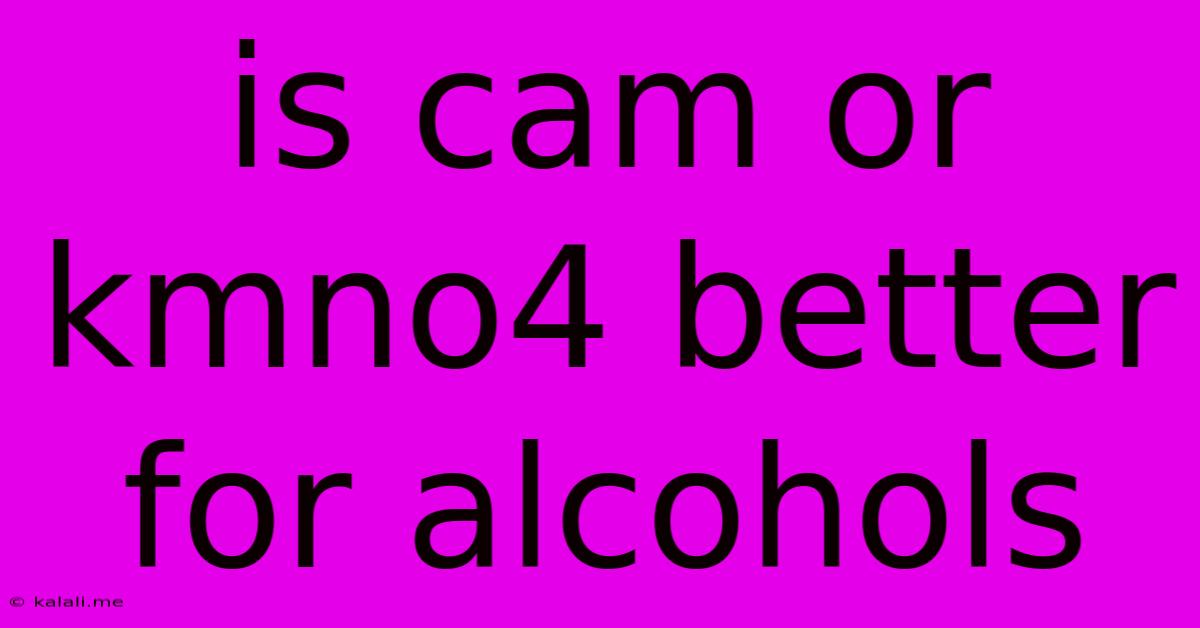Is Cam Or Kmno4 Better For Alcohols
Kalali
Jun 05, 2025 · 3 min read

Table of Contents
Is KMnO₄ or Cam Better for Oxidizing Alcohols? A Comparative Analysis
Meta Description: Choosing between potassium permanganate (KMnO₄) and chromic acid (often represented as "cam" for simplicity) for alcohol oxidation depends on the desired product and reaction conditions. This article compares their strengths and weaknesses.
Oxidizing alcohols is a fundamental reaction in organic chemistry, with various reagents available to achieve this transformation. Two common choices are potassium permanganate (KMnO₄) and chromic acid (H₂CrO₄, often simplified as "cam" in discussions). While both can oxidize alcohols, their effectiveness and suitability vary based on several factors, including the type of alcohol, desired product, and reaction conditions. This article aims to provide a comprehensive comparison to help you determine which reagent is better for your specific needs.
Understanding the Oxidation Process
Before diving into the comparison, let's briefly review alcohol oxidation. Primary alcohols can be oxidized to aldehydes and further to carboxylic acids, while secondary alcohols are oxidized to ketones. Tertiary alcohols, due to the lack of a hydrogen atom on the hydroxyl-bearing carbon, are resistant to oxidation under typical conditions.
Potassium Permanganate (KMnO₄)
KMnO₄ is a strong oxidizing agent that can oxidize a wide range of organic compounds, including alcohols. Its versatility stems from its ability to function in both acidic and basic conditions, leading to different oxidation products.
Advantages of KMnO₄:
- Versatile: Can oxidize primary alcohols to carboxylic acids directly, bypassing the aldehyde intermediate. This is a significant advantage if the aldehyde is unstable or difficult to isolate.
- Strong Oxidizing Power: Effectively oxidizes even sterically hindered alcohols.
- Relatively Inexpensive: Compared to some other oxidizing agents, KMnO₄ is cost-effective.
Disadvantages of KMnO₄:
- Harsh Conditions: Often requires strong acidic or basic conditions, which may not be compatible with all substrates.
- Over-oxidation: Can lead to over-oxidation, particularly in acidic conditions, resulting in unwanted byproducts. Careful control of reaction conditions is crucial.
- Waste Generation: Can generate significant amounts of manganese dioxide (MnO₂) waste, requiring proper disposal.
Chromic Acid ("Cam")
Chromic acid, typically prepared in situ from chromic trioxide (CrO₃) and sulfuric acid, is another powerful oxidizing agent for alcohols. It's often preferred for its selectivity in certain situations.
Advantages of Chromic Acid:
- Selective Oxidation: Under controlled conditions, can selectively oxidize primary alcohols to aldehydes without further oxidation to carboxylic acids. This is particularly useful when the aldehyde is the desired product.
- Faster Reaction Rates: Often exhibits faster reaction kinetics compared to KMnO₄ under appropriate conditions.
Disadvantages of Chromic Acid:
- Toxicity and Carcinogenicity: Chromic acid and its derivatives are highly toxic and potentially carcinogenic, posing significant safety concerns. Handling requires strict safety precautions.
- Environmental Concerns: Chromium-based waste is environmentally hazardous and requires careful disposal.
- Limited Applicability: May not be effective for sterically hindered alcohols.
Choosing the Right Reagent: A Summary Table
| Feature | KMnO₄ | Chromic Acid ("Cam") |
|---|---|---|
| Oxidation Power | Strong | Strong |
| Primary Alcohol Product | Carboxylic Acid (usually) | Aldehyde (under controlled conditions) |
| Secondary Alcohol Product | Ketone | Ketone |
| Toxicity | Relatively low toxicity | Highly toxic and carcinogenic |
| Cost | Relatively inexpensive | More expensive |
| Waste Generation | Significant (MnO₂) | Significant (Chromium waste) |
| Steric Hindrance | Tolerates steric hindrance better | Less tolerant to steric hindrance |
| Reaction Conditions | Can vary (acidic or basic) | Typically acidic |
Conclusion
The choice between KMnO₄ and chromic acid for oxidizing alcohols depends heavily on the specific requirements of the reaction. If a carboxylic acid is the desired product from a primary alcohol and safety is less of a concern, KMnO₄ may be preferable due to its cost-effectiveness and ability to directly form the carboxylic acid. However, if the aldehyde from a primary alcohol is desired, or if minimizing toxicity and waste is a priority, alternative, milder oxidizing agents should be considered, as chromic acid presents significant safety and environmental hazards. Ultimately, careful consideration of the substrate, desired product, and reaction conditions is essential in selecting the most appropriate oxidizing agent. Always prioritize safety and environmentally responsible practices in the laboratory.
Latest Posts
Latest Posts
-
Divide By 3 Circuit Using D Flip Flop
Jun 06, 2025
-
Does Internet Matter For Fps In Minecraft
Jun 06, 2025
-
Should I Pat Dry A Steak After Salting
Jun 06, 2025
-
Please Keep Us Informed Other Words
Jun 06, 2025
-
Hot Water Only Last 15 Minutes
Jun 06, 2025
Related Post
Thank you for visiting our website which covers about Is Cam Or Kmno4 Better For Alcohols . We hope the information provided has been useful to you. Feel free to contact us if you have any questions or need further assistance. See you next time and don't miss to bookmark.